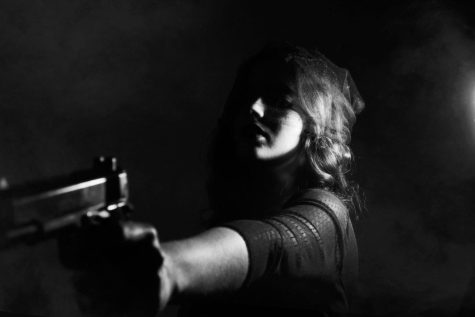Women flock to stories of true crime on TV and podcasts, lured by the grisly details of crime and punishment
July 19, 2022

Editor’s note: This article is from the Communication Department’s award-winning Echo magazine.
As a child, I never liked scary movies. I hated the jump scares, the fake blood made me feel like passing out and, frankly, they gave me nightmares. Particularly during the pandemic, I have found myself opting to watch true crime shows over my usual plethora of comedies, sitcoms and romance movies. My newfound interest came as a shock to me. It wasn’t until I began investigating why we watch and create true crime content that I realized the core purpose of true crime content is similar to my own as a journalist: to give a voice to the voiceless.
An abundance of true crime documentaries have made their way onto Netflix’s most-watched. In the year 2021 alone, 18 serial killer-centered flicks, including “Unsolved Mysteries,” “Night Stalker” and “The Sons of Sam,” spent 232 days in the top 10 listing of shows, according to entertainment industry tracking site The Numbers.
True crime encompasses any nonfiction representation of a crime, spanning books, shows, podcasts, documentaries, music and visual art.
Amanda Vicary, a crime psychologist and associate professor at Illinois Wesleyan University, began her case study “Why Are Women Drawn to Tales of Rape, Murder and Serial Killers” in 2010. After amassing nearly 2,000 participants, Vicary found that those who identify as female are more interested in true crime than their male counterparts. She found that women prefer cases with female victims and enjoyed learning about the killer’s “psychological content,” such as what prompted the perpetrator to kill and how victims were able to make it out alive.
“When you look at all these together, you see that they’re related to survival,” Vicary says. “We know that women have a greater fear of crime than men do. It’s quite possible that women are therefore drawn to these stories because they’re subconsciously or consciously trying to learn how to prevent being the victim of a crime.”
According to FBI data, women accounted for approximately 70% of the victims of serial killers between the years of 1985 and 2010. Simultaneously, women make up at least 75% of careers as crime scene investigators in the forensic sciences, based on a review of accredited forensic science programs conducted by the Associated Press.
Jacqueline Smith, a 24-year-old fashion industry creative consultant, says her interest in true crime first was piqued when she was 6, and has carried on to this day, in the form of podcasts, YouTube videos, documentaries and TV shows.
“I think [true crime content] lets us almost create our own narrative of it in our head, the solving of the case, what actually happened and how we can reconstruct that in our brains,” Smith says. “I think it is so much more than a story. I think it is how humans would react and, for some reason, wanting to prepare yourself if anything like this were to ever happen within the realm of your own life.”
YouTuber Sherrilyn Dale’s True Crime Wine Wednesday channel has more than 100,000 subscribers, 93.6% of whom identify as female. A self-professed “true crime connoisseur,” Dale has discussed everything from conspiracy theories, to cults and notorious killers on her channel. She uses her platform to discuss mental health and to advocate for the victims and their families.
“I feel like my main mission is to connect my viewers to the people we are talking about and really remind everyone that these are real people,” Dale says. “[Families of the victims] have thanked me for giving their loved ones a voice and sharing who they were with the viewers. It really makes this even more real for me and motivates me to help as many people as I can.”
Amid the true crime media wave, TikToker Liz Cooper has garnered more than 4 million followers for videos discussing crime, cosmetics and conspiracy theories, all while earning her master’s degree in clinical psychology. Cooper says her studies are helping her to better understand what causes people to commit crimes or even murders, based on aspects such as upbringing, brain development, developmental models and family cycles.
“I never thought that I would actually have a voice in this community,” Cooper says. “But one day I shared a case that had been on my mind all week, and I realized that I could actually make a real difference by utilizing my platform with something that I am way more passionate about. It’s the first time that I’ve ever felt I had a real sense of purpose and so many of my followers are very proactive about helping.”
Taking a less-digital route, artist Katarina Jacobs creates paintings, ceramic pieces, glasswork and digital art, inspired by life, death, the afterlife and, of course, true crime.
“When I binge on true crime documentaries, I feel more of an expert on my own safety, so I gain something from digesting the content,” Jacobs says. “If you’re afraid of the dark, you want to map out what you can’t see.”
The frightened fascination we once felt as children, gathered around a campfire listening to spooky stories, is alive and well, selling out in bookstores, trending on Netflix and being featured on Spotify. The true crime takeover is underway, and, so it seems, the future is female.
You can read the entire 2022 issue of Echo, as well as previous issues, on our website.







